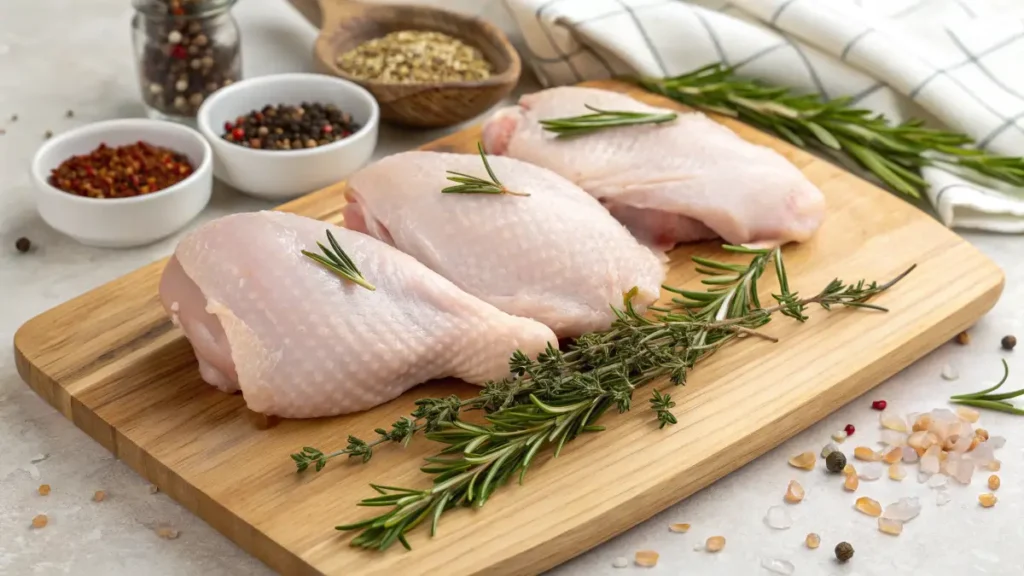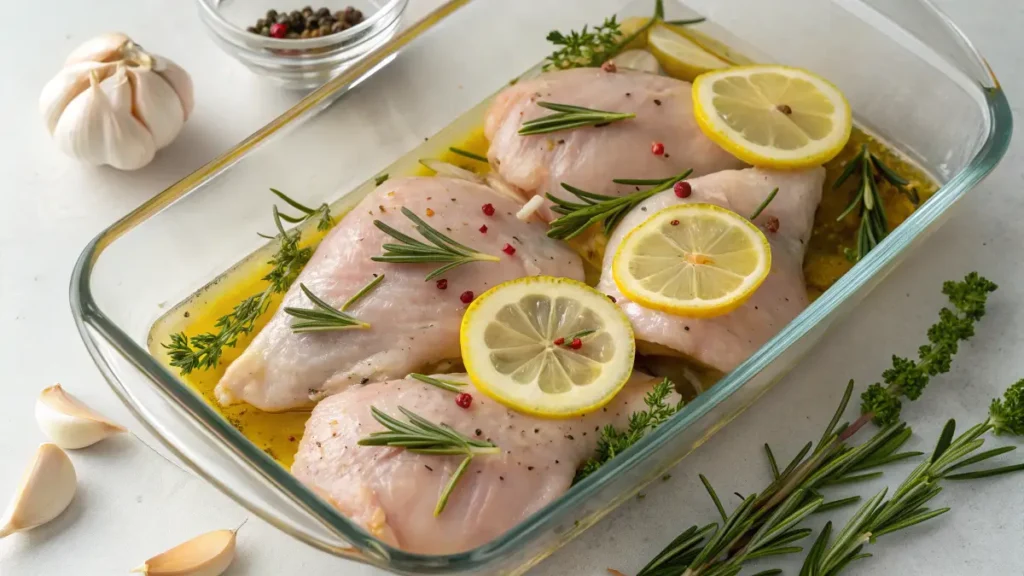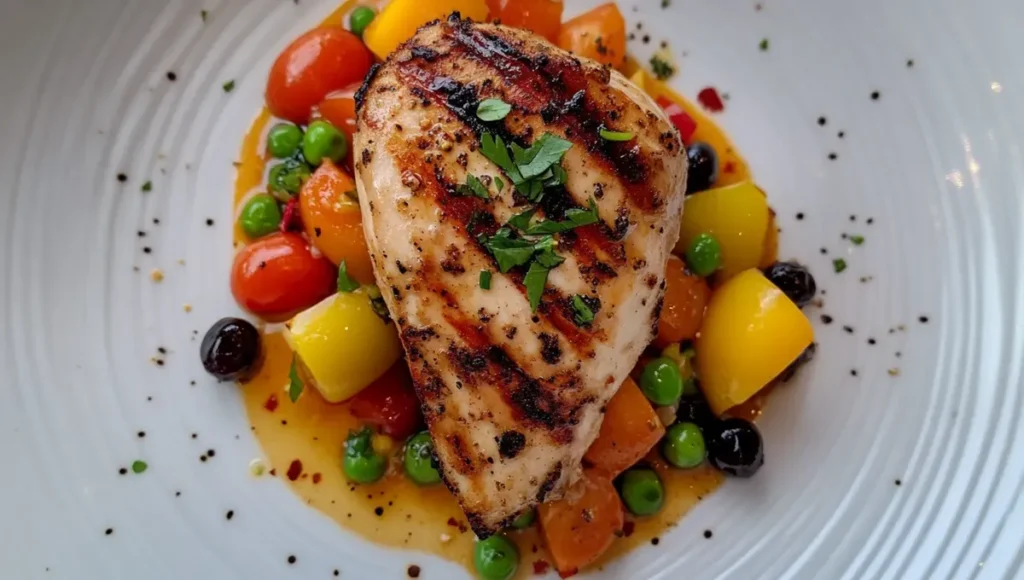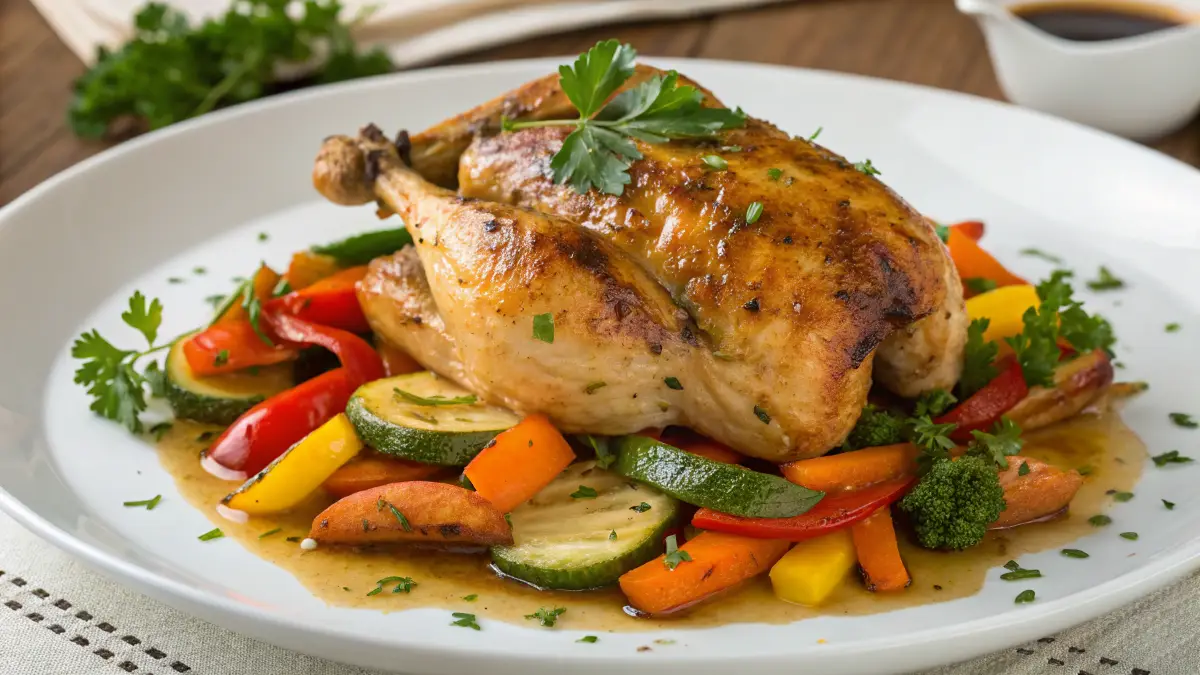Chicken is one of the most versatile and popular proteins in the world, but let’s face it sometimes it can turn out bland or dry. The good news is that with a few simple tricks and techniques, you can transform your chicken into a flavorful, mouthwatering dish. In this guide, we’ll explore everything from choosing the right chicken to experimenting with marinades, seasonings, and cooking methods. Whether you’re grilling, roasting, or pan-searing, these tips will help you master how to make chicken taste good.
Choose Quality Ingredients
Selecting High-Quality Chicken

The foundation of any great chicken dish starts at the store. Opt for fresh, high-quality chicken it’s a game-changer. Look for chicken that’s plump, pink, and free from any strange odors or discoloration.
When possible, choose organic or free-range chicken. These chickens are often raised without antibiotics and fed a natural diet, which not only enhances their flavor but also makes them healthier. While they may cost a little extra, the difference in taste and texture is worth every penny.
Tips for Picking the Best Chicken:
- Check the packaging for “no added water” or “air-chilled” labels. These options often result in better-tasting meat.
- Look for clear sell-by dates to ensure freshness.
- Avoid chicken with dark spots, slimy residue, or an overly strong smell.
Using Fresh Herbs and Spices
Now that you’ve picked out high-quality chicken, it’s time to plan your flavor profile. Fresh herbs and spices are your secret weapon for making chicken taste amazing. Unlike dried herbs, fresh ones have a more vibrant flavor that can completely transform a dish.
For a classic flavor, try rosemary, thyme, or parsley. For something bold, go for cilantro, mint, or dill. Pairing fresh herbs with spices like paprika, garlic powder, or cumin creates a winning combination.
Why Fresh Herbs Matter:
- They bring brightness and complexity to chicken dishes.
- Fresh herbs can double as a garnish to enhance presentation.
- They’re healthier than using pre-made sauces loaded with sodium.
So, before you even start cooking, you’ve already laid the groundwork for success by selecting great chicken and pairing it with the right herbs and spices.
Marinating Techniques to Add Flavor
Benefits of Marinating Chicken
When it comes to how to make chicken taste good, marinating is one of the easiest ways to elevate its flavor. A good marinade not only adds depth to the taste but also helps tenderize the meat, ensuring every bite is juicy and delicious.
Marinating works by breaking down proteins in the chicken, allowing it to soak up the flavors of the marinade. It’s also a great way to experiment with different flavor profiles, whether you prefer savory, tangy, or spicy dishes.
Why Marinating Is Key:
- Enhances both taste and texture.
- Prevents chicken from drying out during cooking.
- Offers endless opportunities to customize flavor.
Simple Marinade Recipes

Creating a delicious marinade doesn’t have to be complicated. Here are two tried-and-true options to get you started:
- Lemon-Herb Marinade
- Ingredients: Olive oil, fresh lemon juice, minced garlic, rosemary, thyme, salt, and pepper.
- Benefits: Adds a zesty, aromatic flavor perfect for grilling or roasting.
- Soy-Ginger Marinade
- Ingredients: Soy sauce, fresh ginger, garlic, sesame oil, and a touch of honey.
- Benefits: Provides a savory, slightly sweet taste with an Asian-inspired twist.
Tips for Marinating Success
To ensure your chicken is packed with flavor, follow these simple marinating tips:
- Time Matters: Let the chicken marinate for at least 30 minutes. For the best results, marinate it for 4–6 hours in the fridge.
- Use the Right Container: Place the chicken in a resealable plastic bag or a glass dish to evenly coat it with the marinade.
- Don’t Overdo It: Avoid marinating chicken for more than 24 hours. Over-marinating can break down the meat too much, leaving it mushy.
By mastering marinades, you’ll have an easy, foolproof way to keep your chicken bursting with flavor every time.
Cooking Methods for Maximum Flavor
Grilling Chicken
Grilling is one of the best ways to learn how to make chicken taste good while adding a smoky flavor to the dish. The high heat caramelizes the natural sugars in the meat, creating a flavorful crust while locking in the juices.
Grilling Tips:
- Preheat the grill to medium-high heat to avoid sticking.
- Brush the chicken with oil or use a marinade to keep it moist.
- Flip only once during cooking to get those signature grill marks.
Roasting Chicken
Roasting is another fantastic way to cook chicken, especially for a crowd. The dry heat of the oven allows the chicken to develop a crispy skin while staying tender and juicy inside.
Steps to Perfect Roasting:
- Preheat the oven to 375°F (190°C).
- Season or marinate the chicken as desired.
- Place the chicken on a baking sheet or roasting pan with space around each piece.
- Bake for 25–30 minutes for smaller cuts or 45–60 minutes for a whole chicken.
The result? Golden-brown, flavorful chicken that’s impossible to resist!
Braising Chicken
For a meal that’s fall-off-the-bone tender, braising is the way to go. This method involves slow-cooking chicken in a flavorful liquid, such as broth or wine, which infuses the meat with rich, deep flavors.
How to Braise Chicken:
- Start by browning the chicken in a skillet to build flavor.
- Add broth, wine, or a mix of both, along with herbs and vegetables.
- Cover and cook on low heat for 1–2 hours, depending on the cut of chicken.
Braising is especially great for bone-in, skin-on chicken pieces like thighs or drumsticks, as they hold up well to long cooking times.
Pan-Searing for Crispiness
If you love crispy chicken with a golden crust, pan-searing is the perfect technique. It’s quick, easy, and brings out incredible flavor.
Tips for Pan-Searing:
- Use a heavy-bottomed skillet, like cast iron, for even cooking.
- Pat the chicken dry before seasoning to ensure a nice sear.
- Cook over medium-high heat for 4–5 minutes per side.
By combining these cooking methods with proper seasoning and marinades, you’ll master how to make chicken taste good in no time.
Enhancing Chicken Flavor with Additional Techniques
Brining Chicken for Moisture and Taste
If you’re serious about how to make chicken taste good, brining is a technique you shouldn’t overlook. Brining involves soaking the chicken in a saltwater solution, which helps the meat retain moisture while infusing it with flavor.
Why Brining Works:
- Salt penetrates the meat, tenderizing it and preventing it from drying out during cooking.
- Optional additions like sugar, herbs, or spices can further enhance the flavor profile.
Simple Brine Recipe:
- 4 cups water
- 1/4 cup salt
- 2 tablespoons sugar (optional)
- Fresh herbs like rosemary or thyme for added flavor
Submerge the chicken completely in the brine and refrigerate for 2–8 hours. Rinse and pat it dry before cooking to avoid excess saltiness. This simple step ensures juicy, flavorful chicken, whether you’re grilling, roasting, or pan-searing.
Using Sauces and Glazes
Another easy way to improve how to make chicken taste good is by using sauces or glazes. They add a layer of flavor that can take your dish from ordinary to extraordinary.
Tips for Applying Sauces:
- Brush the sauce on during the last 5–10 minutes of cooking to prevent burning.
- For extra flavor, reserve some sauce to serve on the side.
- Experiment with sweet, tangy, or spicy glazes to suit your taste preferences.
Popular glaze ideas include honey garlic, barbecue, and teriyaki. These add a delightful shine and depth of flavor to your chicken dishes.
Common Mistakes to Avoid
Overcooking Chicken
One of the quickest ways to ruin how to make chicken taste good is by overcooking it. Overcooked chicken turns dry and tough, losing its appeal.
Tips to Avoid Overcooking:
- Use a meat thermometer to check doneness. Chicken should reach an internal temperature of 165°F (75°C).
- Remove chicken from heat a few degrees early, as it will continue cooking while resting.
Under-Seasoning
Another common mistake is forgetting to season your chicken properly. Even the best cooking techniques won’t save a dish if it’s bland.
Seasoning Tips:
- Season generously with salt and pepper, as they are essential for enhancing the chicken’s natural flavor.
- Add herbs and spices to create layers of taste. A sprinkle of paprika, garlic powder, or chili flakes can make all the difference.
For more delicious recipes, check out this article on leftover rotisserie chicken recipes to inspire your next meal in everytastes.
Presentation and Serving Ideas
Plating Tips to Make Chicken Look Delicious

When it comes to how to make chicken taste good, presentation matters as much as flavor. A beautifully plated dish not only looks more appealing but also makes the dining experience more enjoyable. With a few simple tricks, you can make even a basic chicken dish look restaurant-worthy.
Easy Plating Tips:
- Arrange chicken pieces neatly on a clean, white plate for a professional touch.
- Garnish with fresh herbs like parsley or cilantro for a pop of color.
- Drizzle a bit of sauce or glaze around the chicken for added elegance.
By paying attention to how your dish looks, you’ll elevate the entire meal, making it as pleasing to the eyes as it is to the palate.
Side Dishes That Complement Chicken
A well-paired side dish can enhance the flavors of your chicken and create a more balanced meal. Whether you’re serving grilled, roasted, or braised chicken, choosing the right accompaniments is key.
Best Side Dish Ideas:
- Roasted Vegetables: Carrots, zucchini, and bell peppers add vibrant color and a slight sweetness.
- Mashed Potatoes: Creamy mashed potatoes balance savory chicken flavors perfectly.
- Fresh Salads: A light cucumber or tomato salad offers a refreshing contrast.
These simple additions will not only complement your chicken but also create a complete, satisfying meal.
FAQ Section
When learning how to make chicken taste good, marinades are a game-changer. A basic lemon-herb marinade with olive oil, garlic, and rosemary creates a fresh, zesty flavor. For a savory kick, try a soy-ginger marinade with honey and sesame oil. Both options are simple to make and deliver big on taste.
To avoid dry chicken, always monitor the cooking time. Using a meat thermometer helps ensure the chicken is cooked to 165°F (75°C) without overcooking. Additionally, brining or marinating the chicken beforehand locks in moisture and adds flavor.
Cooking methods like roasting, grilling, and braising are all excellent for making chicken tender and juicy. Pan-searing is another great option for adding a crispy exterior while keeping the inside moist. Brining and marinating also help to achieve that perfect texture.
Fresh herbs like rosemary, thyme, and parsley pair beautifully with chicken. They add layers of flavor and aroma, enhancing the overall dish. Experiment with cilantro or dill for a fresh twist.
Once your chicken has cooled, store it in an airtight container in the refrigerator for up to 4 days. For longer storage, freeze it in a sealed bag or container. When reheating, ensure it reaches an internal temperature of 165°F (75°C) for safe consumption.
Experimenting with Different Flavors
Creating Custom Spice Blends
When it comes to how to make chicken taste good, spice blends are your best friend. Instead of relying on store-bought mixes, creating your own lets you control the flavors and sodium levels. Plus, it’s easier than you think to craft a blend that will elevate your chicken dishes.
Popular Spice Combinations:
- Classic Savory Blend: Paprika, garlic powder, onion powder, black pepper, and a pinch of cayenne for a subtle kick.
- Mediterranean Mix: Dried oregano, thyme, rosemary, lemon zest, and sea salt for a bright and herby flavor.
- Smoky BBQ Rub: Smoked paprika, chili powder, brown sugar, garlic powder, and cumin for a sweet and spicy twist.
Once your blend is ready, generously coat your chicken before grilling, roasting, or pan-searing. The spices will form a flavorful crust, adding texture and taste to each bite.
Trying Global Flavors
Adding international flavors is another fantastic way to master how to make chicken taste good. You can transform a simple chicken recipe into something exciting by using seasonings and marinades inspired by different cuisines.
Examples of Global Flavors:
- Indian: Marinate chicken with yogurt, turmeric, cumin, coriander, and garam masala for a rich and spicy dish.
- Mexican: Use lime juice, chili powder, garlic, and fresh cilantro to create a vibrant marinade.
- Asian: Combine soy sauce, ginger, sesame oil, and a touch of honey for a sweet and savory glaze.
Experimenting with these flavors keeps your chicken recipes fresh and exciting, ensuring every meal feels new and satisfying.
Adjusting Cooking Times and Temperatures
Cooking Times for Different Cuts
Understanding how to cook each cut of chicken properly is key to how to make chicken taste good. Different cuts require different cooking times to avoid drying out the meat or undercooking it.
Quick Cooking Times Guide:
- Boneless, Skinless Chicken Breast: 20–25 minutes at 375°F (190°C).
- Bone-In Thighs: 40–50 minutes at 375°F (190°C).
- Whole Chicken: 1 hour 30 minutes at 375°F (190°C).
Always use a meat thermometer to ensure the chicken has reached an internal temperature of 165°F (75°C). This guarantees your chicken is safe to eat while still juicy and flavorful.
Adjusting Temperatures Based on Cooking Methods
The temperature you use can make or break a chicken dish. Grilling, roasting, or frying each requires slightly different approaches to get the best results.
Tips for Perfect Temperature Control:
- Grilling: Use medium-high heat to get a nice char without drying out the chicken.
- Roasting: Stick to 375°F (190°C) for even cooking and crispy skin.
- Pan-Searing: Keep the heat at medium-high for a golden crust, but reduce to medium for thorough cooking.
By mastering these techniques, you’ll not only improve your cooking skills but also unlock the secret to consistently delicious chicken.
Conclusion
Mastering how to make chicken taste good doesn’t require fancy ingredients or complicated techniques. By starting with high-quality chicken, using fresh herbs and spices, and experimenting with marinades and cooking methods, you can create meals that are packed with flavor and perfectly juicy every time.
Remember to avoid common mistakes like overcooking or under-seasoning, and don’t be afraid to get creative with global flavors or spice blends. Whether you’re roasting, grilling, braising, or pan-searing, paying attention to details like brining and proper cooking temperatures will make a world of difference.
Finally, presentation matters too. Pair your chicken with colorful sides, garnish with fresh herbs, and serve it beautifully to elevate the dining experience. With these tips, you’re well on your way to turning ordinary chicken into a dish that’s as delicious as it is unforgettable.
Ready to get cooking? Try these techniques today and take your chicken dishes to the next level!

